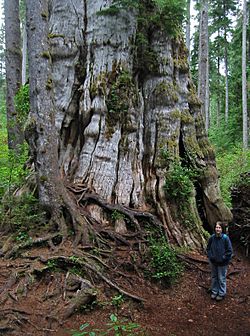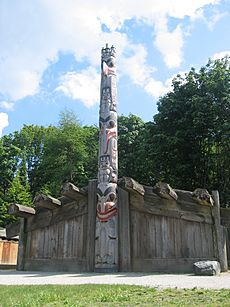Thuja plicata facts for kids
Quick facts for kids Thuja plicata |
|
|---|---|
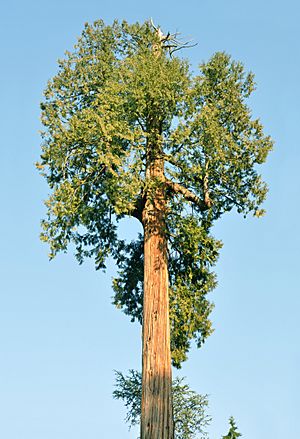 |
|
| An old tree in Vancouver | |
| Conservation status | |
| Scientific classification | |
| Genus: |
Thuja
|
| Species: |
plicata
|
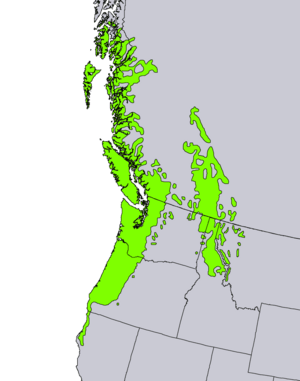 |
|
| Range of T. plicata in the Pacific Northwest | |
The Thuja plicata, often called western red cedar or Pacific red cedar, is a very large evergreen tree. It is also known as giant arborvitae or western arborvitae. This tree is part of the cypress family, Cupressaceae, and grows naturally in western North America. Even though it's called a "cedar," it's not a true cedar tree like those in the Cedrus group.
Contents
- Where Western Red Cedar Grows
- What Western Red Cedar Looks Like
- Name and History
- Tree Health and Diseases
- Insects that Like Western Red Cedar
- Famous Western Red Cedar Trees
- How Western Red Cedar is Used
- Special Chemicals in Western Red Cedar
- Western Red Cedar and Indigenous Peoples
- Health and Safety
- Images for kids
- See also
Where Western Red Cedar Grows
The western red cedar is one of the most common trees in the Pacific Northwest region. It often grows alongside Douglas fir and Western hemlock trees. You can find it from sea level up to high mountains, sometimes as high as 7,500 feet (2,290 meters) above sea level.
Besides growing in thick forests and on mountainsides, this tree also likes to grow near water. It is often found in swamps and along streambanks. The western red cedar can grow well even in deep shade, and new trees can start growing under the shade of older trees.
This tree has also been planted in other parts of the world with mild climates. You can find it in western Europe, Australia, New Zealand, and even in higher parts of Hawaii. It has even started growing on its own in Britain.
What Western Red Cedar Looks Like
The western red cedar is a very big tree. It can grow up to 210 to 230 feet (65 to 70 meters) tall. Its trunk can be 10 to 23 feet (3 to 7 meters) wide. If a tree grows in an open area, its branches might reach all the way to the ground. But if many trees grow close together, their branches will only be at the very top, where they can get sunlight.
These trees live a very long time. Some can live for more than a thousand years! The oldest known western red cedar lived for 1,460 years.
The leaves are flat and look like small scales. They grow in pairs, with each pair at a right angle to the one before it. The top of the leaves is green, and the underside has whitish lines. If you crush the leaves, they smell strongly, a bit like pineapple. The small leaves are about 0.04 to 0.16 inches (1 to 4 millimeters) long.
The cones are thin and about 0.4 to 0.7 inches (10 to 18 millimeters) long. They have 8 to 12 thin, overlapping scales. They start out green or yellow-green and turn brown in the fall. When they are ready, they open up to release their seeds. The seeds are small, about 0.16 to 0.2 inches (4 to 5 millimeters) long, and have a papery wing on each side to help them fly in the wind. The pollen cones are tiny, about 0.12 to 0.16 inches (3 to 4 millimeters) long, and release yellow pollen in the spring.
Name and History
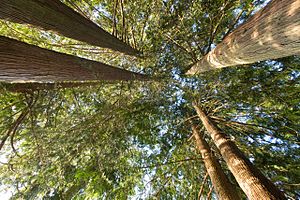
The western red cedar is one of two Thuja species that grow naturally in North America. The other is the Northern white cedar. The scientific name plicata comes from a Latin word meaning "folded" or "braided." This describes the pattern of its small leaves.
Most experts call it "western redcedar" (one word or hyphenated) to show that it is not a "true cedar" from the Cedrus group. In gardening, it is also known as "giant arborvitae." The word "arborvitae" means "tree of life" in Latin. Interestingly, Native Americans on the West Coast also called this tree the "long life maker."
One name for the tree in the Halkomelem language (spoken by some Indigenous peoples) is xepá:y. This name relates to the tree's bark and its use in carving.
Tree Health and Diseases
Western red cedar trees are quite strong against many diseases that affect other trees. They are less likely to get certain root rots and other fungal infections. This is because the tree produces a special chemical called thujaplicin. This chemical acts like a natural fungicide, protecting the wood from rotting. This protection can last for about 100 years, even after the tree has been cut down!
Young western red cedars do not produce this chemical, so they can sometimes get rot when they are small. As they grow older, they start making thujaplicin and heal themselves, which can sometimes lead to a hollow trunk.
Insects that Like Western Red Cedar
Some insects are attracted to the western red cedar. These include the western cedar borer and the cedar bark beetle.
Famous Western Red Cedar Trees
The largest living western red cedar is called the Cheewhat Giant. It is located in Pacific Rim National Park Reserve on Vancouver Island and has a huge amount of wood inside it. The tallest known western red cedar is the Willaby Creek Tree, which is 195 feet (59 meters) tall.
The "Quinault Lake Redcedar" used to be the largest known western red cedar in the world. It was located near Lake Quinault in Washington. This tree was 174 feet (53 meters) tall and nearly 20 feet (6 meters) wide at its base! Sadly, this giant tree was destroyed by storms in 2014 and 2016.
Another very tall and old red cedar, over 230 feet (71 meters) tall and 700 years old, stood in Cathedral Grove on Vancouver Island. Sadly, it was burned down by vandals in 1972.
How Western Red Cedar is Used
Timber and Wood Products
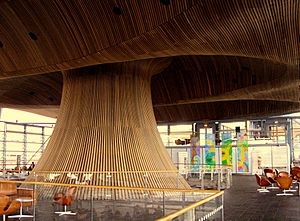
The wood of the western red cedar is soft and has a reddish-brown color. It has a straight grain and not many knots. People love this wood because of its unique look, its pleasant smell, and how well it resists decay. This makes it perfect for building things outdoors, like fences, decks, roof shingles, and house siding.
It is also used to build lightweight sailboats and kayaks. In bigger boats, it is often used between layers of other materials like fiberglass. Western red cedar wood is light, weighing about 30% less than other common boat-building woods. It is strong for its weight, but can be a bit brittle. It glues together well.
The wood used for insect-repelling closet linings and cedar chests usually comes from a different tree called Juniperus virginiana, also known as eastern red cedar.
Because it is light, strong, and makes a warm, dark sound, western red cedar is a popular choice for guitar soundboards, especially for guitars made in Europe.
Growing Western Red Cedar
Like its relative, the Northern white cedar, the western red cedar is grown as an ornamental tree in gardens and parks around the world. People plant it for its beauty and to create screens or hedges. There are many different types of western red cedar that vary in shape, size, and color.
Some popular types of western red cedar that have won awards for being great garden plants include 'Atrovirens', 'Aurea', 'Stoneham Gold', 'Whipcord', and 'Zebrina'.
Other Uses
Western red cedar is also widely used in Europe and America to make parts for beehives.
Special Chemicals in Western Red Cedar
The inner wood of older western red cedar trees contains special chemicals called thujaplicins. These chemicals are what give the wood its natural ability to resist rotting from fungi. This is why the wood lasts so long, even after the tree is cut down.
Some of these chemicals are also used in agriculture to help prevent fungal diseases and stop vegetables from rotting after they are harvested.
Essential Oil
The leaves of the western red cedar contain essential oils with natural compounds. Some of these compounds are used in perfumes because of their pleasant smell.
Western Red Cedar and Indigenous Peoples

The western red cedar has been incredibly important to the indigenous peoples of the Pacific Northwest Coast for thousands of years. Some tribes even call themselves "people of the redcedar" because they relied so much on this tree for their daily lives.
The wood was used to build houses and totem poles. It was also crafted into many useful and beautiful objects, like masks, tools, boxes, musical instruments, and canoes. The roots and bark were used to make baskets, ropes, clothing, blankets, and rings. Western red cedar was also used for curing and cooking fish over a fire.
History of Use
Many old archaeological discoveries show that red cedar wood has been used by Native societies for a very long time. Tools for woodworking, like carved antlers, have been found that are 8,000 to 5,000 years old. Baskets, ropes, and even parts of ships from 3,000 years ago have been found.
When First Nations people took bark from cedars, it left a scar on the tree. These trees are called "Culturally Modified Trees" (CMTs) and can still be seen today.
A legend among the Coast Salish peoples tells how the western red cedar came to be. It says that a generous man gave people everything they needed. When the Great Spirit saw this, he said that when the man died, a great red cedar tree would grow where he was buried. This tree would be useful to all people, providing roots for baskets, bark for clothing, and wood for shelter.
Tools for Working with Wood
The main tool used to work with the wood was the adze. Indigenous peoples preferred this tool even over those brought by Europeans, like saws or axes. Tools were usually made from stone, bone, or harder wood. They also used hammers, wedges, chisels, and knives.
Archaeological digs have found iron tools that are nearly 800 years old, long before Europeans arrived. It is thought that these iron tools might have come from shipwrecks from East Asia or from contact with iron-using cultures in Siberia.
Harvesting Wood
Cutting down large red cedar trees before steel tools were available was a difficult and long process. First, the bark was removed from around the base of the tree. Then, people would cut and split the wood with stone adzes and hammers, making a triangular cut. The area around the cut was covered with wet moss and clay to stop fire from spreading. Then, small pieces of wood were packed into the cut and slowly burned. This process of cutting and burning would continue until the tree was almost cut through. Then, by carefully managing the fire, the tree would fall in the best direction. This whole process could take many days, with workers taking turns to keep the fires burning day and night.
Once the tree was down, the hard work continued. It had to be stripped and dragged to the shore. If the tree was to become a canoe, it was often shaped roughly into a canoe before being moved. If it was for a totem pole or building materials, it was towed whole to the village. Some artists still cut down trees in this traditional way for totem poles and canoes, believing it keeps the art's spirit alive.
If only planks for houses were needed, they would be split from a living tree. The bark was removed, and cuts were made at the ends of where the plank would be. Then, wedges were hammered in along the sides, and the planks were slowly split off the side of the tree. You can still see trees in some rainforests with large chunks taken out of their sides from this method. These trees usually continue to grow well because red cedar wood resists decay. Planks were straightened by weighing them down with stones or tying them together.
Red cedar wood was used to make very large canoes. Men used these canoes to hunt whales and trade with other groups. One famous canoe, a 38-foot (11.6-meter) craft, was bought in 1901 by Captain John Voss. He named it Tilikum and sailed it on a three-year journey from British Columbia to London.
Red cedar branches are very flexible and strong. They were stripped and used as strong cords for fishing lines, ropes, and other uses where bark cord was not strong enough. Today, modern ropes have mostly replaced these traditional ones, but the bark is still used for other purposes.
Harvesting Bark
At the right time of year, the bark can be easily removed from live trees in long strips. It is used to make mats, ropes, baskets, rain hats, clothing, and other soft items. It is important to harvest bark carefully, as taking too much can kill the tree. Harvesters usually only take bark from trees that have not been stripped before. After harvesting, that tree is not used for bark again, though it might later be cut down for wood.
To remove bark from high up, people used platforms hung on ropes around the tree. They would climb by moving between these platforms. Since red cedars lose their lower branches as they grow tall, a harvester might climb 33 feet (10 meters) or more into the tree this way. The harvested bark was folded and carried in backpacks. It could be stored for a long time because mold does not grow on it. Before using it, the bark was moistened, then split lengthwise and woven or twisted into shape. Women usually did the bark harvesting, even though it was dangerous to climb so high, because they were the main makers of bark goods.
Today, making bark rope is a lost art in many communities, but other uses of bark are still common for art or practical items. Recently, there has been a renewed interest in cedar weaving, leading to new products like cedar roses for decorations.
Health and Safety
Western red cedar wood can cause allergic reactions in some people, especially those who work with it often, like woodworkers or loggers. These reactions can include developing occupational asthma, making existing asthma worse, reducing lung function, and causing eye irritation. About 5% of workers are allergic to western red cedar.
Images for kids
-
An old tree in Vancouver
-
Range of T. plicata in the Pacific Northwest
-
Western red-cedars on Keats Island, British Columbia, in May 2017
-
Canadian western redcedar cowl in the National Assembly for Wales
-
Klallam people and canoe, ca. 1914
-
A totem pole outside a six-post house at the University of British Columbia
See also
 In Spanish: Tuya gigante para niños
In Spanish: Tuya gigante para niños







